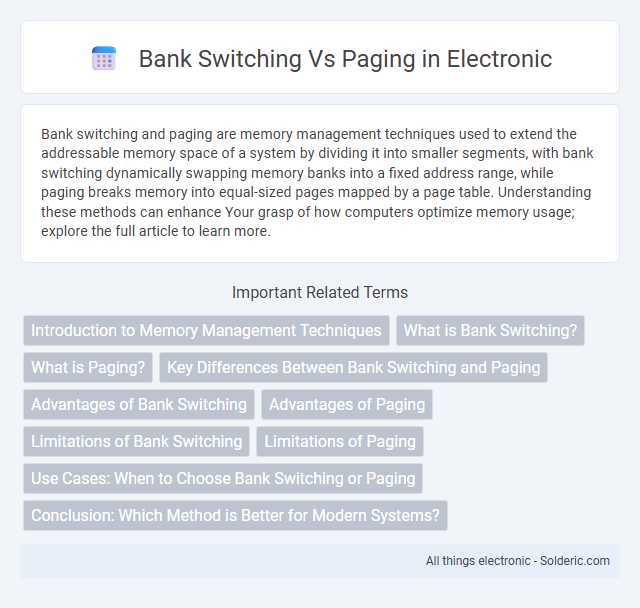Bank switching and paging are memory management techniques used to extend the addressable memory space of a system by dividing it into smaller segments, with bank switching dynamically swapping memory banks into a fixed address range, while paging breaks memory into equal-sized pages mapped by a page table. Understanding these methods can enhance Your grasp of how computers optimize memory usage; explore the full article to learn more.
Comparison Table
| Feature | Bank Switching | Paging |
|---|---|---|
| Definition | Technique that switches between multiple memory banks to extend addressable memory. | Memory management that divides memory into fixed-size pages to map virtual to physical addresses. |
| Memory Management | Manual switching of memory banks by hardware or software. | Automatic management by the operating system and hardware (MMU). |
| Address Space | Limited address space extended via banks. | Large virtual address space mapped to physical memory. |
| Hardware Support | Requires hardware support for bank select signal. | Requires Memory Management Unit (MMU) support. |
| Complexity | Simple but programmer-controlled switching. | Complex, transparent to the user. |
| Typical Use | Older or embedded systems with limited address lines. | Modern operating systems for efficient memory management. |
| Performance Impact | Switching overhead can affect performance. | Efficient due to hardware-managed paging and caching. |
Introduction to Memory Management Techniques
Bank switching and paging are memory management techniques designed to extend the addressable memory space beyond hardware limitations. Bank switching involves dividing memory into multiple banks and switching between them manually to access different segments, commonly used in older or embedded systems with limited address buses. Paging, a more advanced technique employed in modern operating systems, breaks memory into fixed-size pages mapped dynamically through page tables, enabling efficient virtual memory management and protection.
What is Bank Switching?
Bank switching is a memory management technique that allows a computer to access more memory than the CPU's address bus can directly address by dividing memory into separate "banks" and switching between them as needed. This method enables systems with limited address space to selectively map different memory banks into the same address range, increasing effective memory capacity without hardware changes. Bank switching is commonly used in early video game consoles and embedded systems to expand available RAM or ROM beyond built-in constraints.
What is Paging?
Paging is a memory management scheme that eliminates the need for contiguous allocation of physical memory, allowing the physical address space of a process to be noncontiguous. It divides the process's virtual memory into fixed-size blocks called pages, which are mapped to physical memory frames through a page table. This method enhances system efficiency by enabling more flexible and dynamic allocation of memory, reducing fragmentation, and simplifying memory protection.
Key Differences Between Bank Switching and Paging
Bank switching involves manually changing memory banks to access different memory segments in limited address spaces, while paging uses a fixed-size memory management scheme that divides memory into pages mapped automatically by the hardware. Bank switching requires explicit control from the software to switch banks, whereas paging allows seamless memory address translation through page tables managed by the operating system. Key differences include manual versus automatic memory segmentation, hardware dependency in paging for address translation, and the flexibility of paging to support virtual memory compared to bank switching's reliance on physical memory segments.
Advantages of Bank Switching
Bank switching allows access to a larger memory space than the CPU's address bus can normally handle, enabling more complex programs and data storage. This technique offers faster memory access compared to paging by avoiding the overhead of page table lookups and translation. Your system benefits from reduced latency and simplified hardware control, making bank switching ideal for real-time applications.
Advantages of Paging
Paging allows efficient memory management by dividing physical memory into fixed-size blocks called pages, reducing external fragmentation commonly seen in bank switching systems. It supports virtual memory implementation, enabling systems to use disk storage to extend RAM capacity, which enhances multitasking and application performance. The uniform page size simplifies allocation and protection mechanisms, improving overall system stability and security.
Limitations of Bank Switching
Bank switching faces limitations such as increased hardware complexity and limited addressable memory expansion due to fixed bank sizes. It restricts simultaneous access to multiple banks, causing overhead in switching operations and reducing system efficiency. In contrast, paging allows dynamic memory mapping without physical hardware changes, offering improved flexibility and better utilization of available memory.
Limitations of Paging
Paging faces limitations including overhead from managing page tables, which consume significant memory and processing power, especially with large address spaces. Fragmentation issues, though reduced compared to segmentation, still impact system efficiency due to fixed-size pages that may not align perfectly with process memory needs. Paging also incurs performance penalties from frequent page table lookups and potential page faults, leading to slower access times compared to bank switching.
Use Cases: When to Choose Bank Switching or Paging
Bank switching is ideal for embedded systems and retro hardware with limited address space, allowing access to larger memory by switching between fixed memory banks. Paging suits modern operating systems managing large virtual memory, enabling efficient use of physical RAM by mapping dynamic pages. Your choice depends on system architecture and memory management needs, with bank switching preferred for simplicity and paging for scalability.
Conclusion: Which Method is Better for Modern Systems?
Bank switching offers simple implementation and low latency, making it suitable for limited-memory or legacy systems, but its scalability is restricted by fixed bank sizes and hardware complexity. Paging provides more flexible and efficient memory management with support for virtual memory, enabling better utilization of large address spaces typical in modern systems. For your applications requiring dynamic memory allocation and security, paging is generally the preferred method in contemporary computing environments.
bank switching vs paging Infographic

 solderic.com
solderic.com